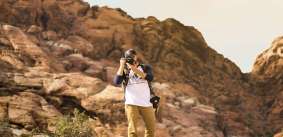Last Updated on June 27, 2023
Desert photography offers a captivating opportunity to capture the breathtaking beauty of these awe-inspiring landscapes.
From the vast expanse of sand dunes to the ethereal salt flats, deserts provide a unique setting for photographers to unleash their creativity and create stunning images that leave a lasting impression

Tips for Desert Photography
1. Check the weather and scout ahead of time
Before embarking on your desert photography expedition, it’s essential to check the weather forecast.
Deserts can be harsh and unforgiving, with extreme temperatures and limited resources. By knowing the weather conditions in advance, you can prepare accordingly and ensure your safety.
Additionally, scouting your shooting locations ahead of time allows you to familiarize yourself with the terrain, identify interesting features, and plan your compositions effectively.
2. Avoid midday shoots
Midday in the desert often brings scorching temperatures and harsh, unflattering light. To capture the true beauty of the desert, it’s advisable to avoid shooting during this time. Instead, schedule your photography sessions during the early morning or late afternoon when the sun is lower on the horizon, creating softer and more appealing lighting conditions.
Alternatively, seek shade during the midday hours or explore indoor photography opportunities.
3. Pack the right gear and equipment
When venturing into the desert, ensure you have the appropriate gear and equipment to make the most of your photography experience.
Alongside your camera and lenses, consider bringing a sturdy tripod to stabilize your shots, especially for long exposures or panoramic images.
Don’t forget essentials like extra batteries, memory cards, lens cleaning tools, and a remote shutter release for added convenience.
Additionally, pack ample water, sunscreen, a hat, and clothing suitable for protection against the desert environment.
4. Stack composition tools
Desert landscapes can appear vast and barren, presenting unique challenges when it comes to composition. To create visually captivating images, employ various composition techniques.
Experiment with leading lines that draw the viewer’s gaze into the frame, utilize negative space to emphasize the vastness of the desert, or seek out symmetrical elements for a balanced composition.
By combining these composition tools, you can add depth, interest, and visual impact to your desert photographs.
5. Take a panoramic shot
To fully capture the grandeur and expansive nature of the desert, consider taking panoramic shots. With the help of a tripod and a panoramic head, you can seamlessly stitch multiple images together to create a wide-angle panorama that showcases the breathtaking vistas in their entirety.
Panoramic shots provide a unique perspective and allow viewers to immerse themselves in the vastness of the desert landscape.
6. Use flash (not always, but try it)
While natural light is often preferred in desert photography, there are instances where the creative use of flash can add a touch of drama and intrigue to your images.
Experiment with off-camera flash or diffusers to fill in shadows or highlight specific elements within the desert landscape.
However, exercise caution and ensure that the flash does not overpower the delicate balance of natural light and the unique atmosphere of the desert.
7. Capture sunset silhouettes
Sunsets in the desert offer a magical backdrop for silhouette photography. As the sun descends below the horizon, the warm hues of the sky provide a stunning canvas for capturing silhouettes of cacti, rocks, or other prominent desert features.
Position your subjects against the vibrant colors of the setting sun, adjust your exposure to highlight the sky, and let the captivating silhouettes tell a story of the desert’s beauty.
8. Catch the stars
The vastness and minimal light pollution of deserts make them ideal for astrophotography. Capture the mesmerizing beauty of the night sky by photographing stars, constellations, or even the Milky Way.
To achieve crisp and detailed images of the stars, use a sturdy tripod to minimize camera shake, set a wide aperture to gather as much light as possible, and employ longer exposure times.
Experiment with different compositions and camera settings to create stunning nightscapes that showcase the desert under a celestial canopy.
9. Experiment with different techniques
Desert photography is an opportunity to unleash your creativity and experiment with various techniques.
Embrace long exposures to capture the movement of sand dunes or create ethereal effects with flowing water, if present.
Explore the high-contrast beauty of black and white photography to emphasize textures and shapes in the desert landscape.
Additionally, consider employing HDR (High Dynamic Range) techniques to capture a wider range of tonal detail in scenes with extreme light contrasts.
Allow yourself to explore and discover new possibilities that bring out the unique characteristics of the desert environment.
10. Have fun!
Above all, remember to have fun and enjoy the process of desert photography.
The desert offers a captivating and inspiring backdrop for your creativity to thrive.
Embrace the challenges, take your time to connect with the landscape, and let the serene beauty of the desert fuel your passion for photography.
Cherish the experience and the memories you create as you capture breathtaking images that will leave a lasting impression on both yourself and those who view your work.

Your n°1 source of information on the world of sandsports and desert adventure travel. Our articles are the result of extensive research, personal experience, and knowledge-sharing within the global sandboarding community.



